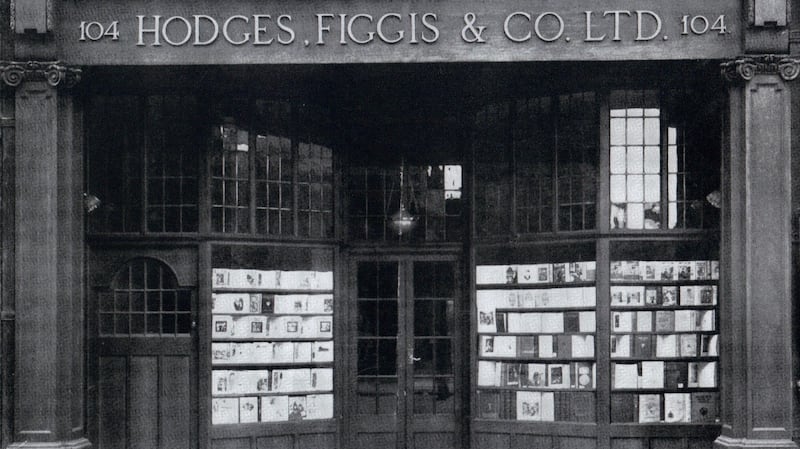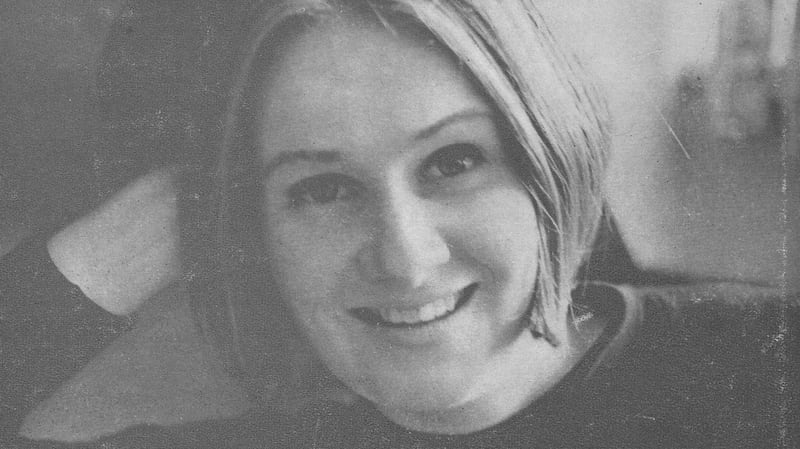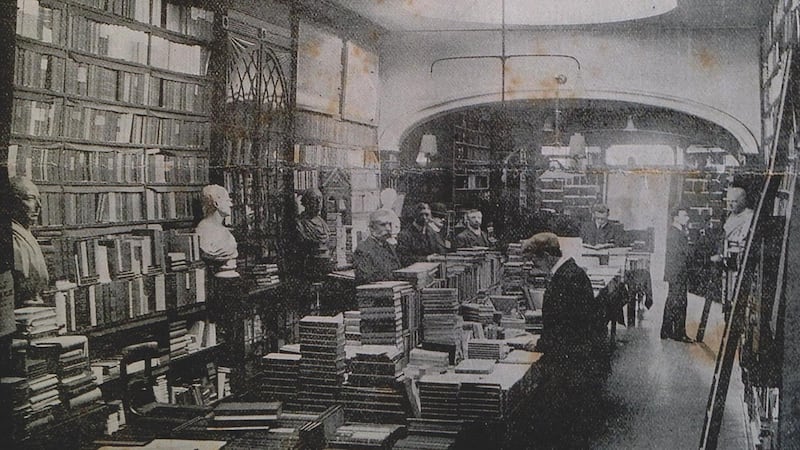Hodges Figgis closed down for four hours in 1995. It was to allow for the legal transfer of ownership from UK company Pentos to new owners Thorn EMI, and the doors were locked for a few hours. Other than that brief hiatus the Dublin bookshop Hodges Figgis has been around for 250 years. What did they do inside while it was closed? Manager Liam Donnelly shugs. "We tidied up. As you do."
Hodges Figgis is – probably – the third oldest bookshop in the world. It’s a long time for any institution to maintain a tradition and stay in the same business, even as its ownership, and indeed name, ebbs and flows.
It’s “a place like Clery’s clock, around a long time”, observes Donnelly.
Although now owned by Waterstones, the shop still has the feel of an indie to it, with longstanding reader and writer loyalty and knowledgable staff. Donnelly talks about how a bookseller’s head works differently.
“It’s important these days to talk to our customers about books in the shop. That’s the only way you can distinguish yourself from the internet, which is just an algorithm. When a reader asks a question, the bookseller’s head will work differently, and might just jump around the place and suggest different things. That is what bookselling is about. A staff that can almost divine what a reader wants.”
The shop stocks a jawdropping 70,000 titles (with about a million books on the premises at any given time); to give that context, other large chains here who concentrate more on best-sellers stock perhaps 12,000 titles.
The bookshop was founded in 1768 by John Milliken, whose father owned property around the Grafton Street area (then part of the suburbs). Milliken's shop was centre city at the time, at 10 Skinner's Row near Christ Church Cathedral.
Anthology
In Reading the Future, an anthology published to mark Hodges Figgis's anniversary, managers Donnelly and Tony Hayes outline a brief history of HF; the shop's changing locations and shop titles are a Lanigan's Ball, but there is nonetheless a consistent thread of bookselling and, for nearly 200 years, publishing.
On the top floor of the bookshop’s current home, Donnelly’s take is that through most of the shop’s history “Dublin was an incredibly poor place, and this place survived on rich Protestants. And then on more rich Protestants for a while. And then probably post-1900 it became part of the city life.”
In 1797 Milliken moved the shop to 32 Grafton Street as the city expanded. As we look at some of the shop’s records, manager Gina O’Donnell points out references from the bicentenary 50 years ago to Milliken’s loyalty to the crown; the shop sold books and pamphlets in support of the union of the Irish and English parliaments.
The records point out that his son Richard Milliken, who took over from him, was also "ultra-loyalist". He had an enormous family: apparently he stood with his 22 daughters dressed in white on the Grafton Street balcony to welcome George IV in 1825. That would have been at 104 Grafton Street, where the shop moved in 1819 to become a centre of learning in Dublin for over a century.
Richard's son Andrew took over in 1834, but ran into difficulties, and the business was taken over by Hodges and Smith, booksellers in College Green. But look at the continuity: on the deed of assignment is mentioned William Foster, a nephew and apprentice of the original Andrew Milliken. However, Hodges and Smith signaled change too, with a more liberal outlook towards Ireland and books of Irish interest. George Smith published many significant books, particularly John O'Donovan's edition of the Annals of the Four Masters in 1848, which he may have funded personally.
Partnership
Here's where the names waltz in and out. After John Hodges's death in 1853, Smith went into partnership with William Foster and became Hodges Foster & Co, until Smith's retirement, when Samuel Figgis, who worked at the company, came on board. After Foster's retirement, Samuel Figgis created a limited company in 1892. The name Hodges Figgis was born, and stuck.
It was from that 104 Grafton Street era that Joyce's passing reference in Ulysses comes: Stephen tries to answer "What she?" (to whom might he address his ardent, metaphysical words), and thinks of a bookish "virgin at Hodges Figgis' window" he spotted three days earlier and gave a "keen glance".
Samuel Figgis's son William Fernsley Figgis (known as WF) joined the firm and remained for over 60 years , along with a genial Scotsman Thomas Brown, who became managing director following Samuel Figgis's death in 1899. The firm prospered.

But a rebuilding debt and William Figgis's absence in the army during the first World War brought financial pressure, and in 1920 he accepted an offer from the Provincial Bank to redeem the loan, taking the firm's stock-in-hand and goodwill in lieu of cash for the premises. After over a century at 104 Grafton Street, Figgis left with Thomas Brown and set up the shop at 20 Nassau Street, where it stayed for a quarter of a century.
Ups and downs
These were eventful years for the new State and beyond with the second World War; the ups and downs for the shop included another move to 6 Dawson Street in 1945.
After William Figgis died in 1956, his son Allen continued its expansion, incorporating No 7 next door in 1963, and opening a paperback centre in Suffolk Street.
Allen Figgis's shop was a huge business and a hive of literary activity. He was very committed to Irish writers, republishing out-of-print titles such as Padraic Colum in a series called Riverrun, as well as younger writers, and an Encyclopaedia of Ireland in 1968 (edited by Victor Meally, with assistant editors including Eavan Boland, Anthony Glavin and Eoghan O Tuairisc).
Phyl Hebert was PA for Allen Figgis Publishing House in the 1960s. “Allen was a very shy man,” she says, “but he wasn’t afraid to think big and bold”.
She recalls “a very colourful staff roamed around the huge space. On one side of the shop was the antiquarian section which also included books as Gaelige; Padraic O’Tailluir was a huge character in that section as was a Mr JF Murray. They had all the grace of characters from a Victorian novel. There were many old world traditions exercised there, and on Christmas Eve there was always a sherry reception for the customers.”
HF's readings and book launches have a long tradition. Herbert recalls huge launches, particularly one for An Tain, published by Dolmen Press – "the three men of the book were present, Louis Le Brocquy, Paul Funge and Thomas Kinsella". Young writers Brendan Kennelly, Eavan Boland and Derek Mahon were in and out of Allen Figgis's offices.
Top shelves
Boland recalls going "in to Hodges Figgis first in my last year of boarding school. I thought the interior was almost festive, with ladders reaching up to the top shelves, and books piled neatly on tables. The bookstore looked like what it was: a hub, a meeting-place, an intersection for readers and writers. Allen, or Teddy Figgis as he was known, presided over it all with grace and humour. Later he published my first book, and Brendan Kennelly and I gave a reading there. I remember the big windows onto Dawson street and that sense of community. And I've always been grateful for those memories."

Figgis also published Brendan Kennelly. "I remember the launch dinner for Dream of a Black Fox," says Herbert. "It was a sit-down meal. He couldn't do enough for Brendan."
Brendan Kennelly, who turned 82 this month and is now retired in Kerry, says “Allen Figgis was a good friend and a great publisher. He was a pleasant man and I enjoyed his company very much; he was easy to be around. He was a shy man but you could say whatever you liked and he replied in his own way. Hodges Figgis was like a second home for me. The bookshop was a few minutes’ walk from Trinity where I worked and I loved going in there and getting lost among the books.”
“The shop was staffed by very qualified people,” says Herbert. “A big schools and university section was kept busy. Allen liked also to have attractive Trinity students working on the floor, preferably young girls. Brendan Kennelly kept them amused as he walked through the shop to Allen’s office.”
Herbert also worked at the Focus Theatre and Lantern Theatre. “As you know theatre is very time consuming,” she recalls, “and Allen used often advise me to give up that play-making thing!”
The shop moved again in 1974, to St Stephen's Green, and Figgis expanded the empire – into Donnybrook, Dún Laoghaire, Kilkenny and Cork City, and campus shops in Belfield, Cork and Galway.
Moved next door
But the family link eventually broke, and Allen Figgis sold the business to Pentos in 1978. The shop moved to 56 Dawson Street, and by 1981 its other shops had closed. A few years later it moved next door to 57-58 Dawson Street and in 1992 reintegrated No 56. In 1995 EMI acquired Pentos, later merging with Waterstones as part of HMV. In 2011, Russian billionaire Alexander Mamut bought Waterstones and Hodges Figgis from HMV.
Donnelly, who has lived through those recent corporate waltzes, comments that the current one is the “most book-friendly ownership”.
Even with such corporate change, the shop seems to have retained its heart, and an individuality. Undoubtedly its strong brand identity is good for business.
“The nature of what we do has changed with internet shopping and online books, but the shop stays because it provides a social space,” says Donnelly.
It has long been a draw for writers, with launches and readings every week. Donnelly, who's worked there since 1990, and O'Donnell, there since 1980, talk about people meeting up in the thronged shop at Christmas, and regular visiting celebrities popping in for books over the years, from Billy Connolly and John Huston to Bruce Springsteen and Charles Dance. That's aside from Irish actors and musicians, and "every Irish writer worth their salt".
“They all read, which is great,” says O’Donnell. “And they all shop here.”
Hodges Figgis itself pops up in literature, aside from that famous Joycean reference. A chapter of Sally Rooney's Conversations With Friends takes place there at Christmas; and it gets a mention in John Boyne's The Heart's Invisible Furies.
Paul Durcan's poem On Glimpsing A Woman in Hodges Figgis Bookshop in Dublin is an amusing observation of Amanda Brunker – "an unlikely looking book psychopath" – secretly signing her own books.
‘We sold millions’
For the managers, some things stand out. Attenborough's Life on Earth – "it took off, we sold millions" and the queue for signing went around the block. The various midnight queues for Harry Potters for some reason went round the other block. Dava Sobel's Longitude "roared out the door".

The excitement of a new book like Colm Toibin's The Heather Blazing. Norman Mailer was "very short, and taciturn. But engaging on the night," says Donnelly. He recalls that at the launch of Yugoslavia My Fatherland, Bosnian writer Goran Vojnovic had a public disagreement with the Serbian ambassador.
O'Donnell remembers running around after Michael Douglas buying books. At a Rick Stein launch a couple of years ago over 300 people were "squashed in". There was the furore over Spycatcher in 1987; it was banned in the UK, but HF sourced it further afield. Looking at the queues for Stalker in 1988, and wondering "omigod, will we have enough books for all these people?"
People travel to the shop, and HF sent books abroad long before online sales. Donnelly wrote "for years to a bloke in China, sending him books on Yeats" because he couldn't get them there in the pre-internet '90s".
And Lafcadio Hearn fostered a huge interest in Irish studies on Japan so they shipped lots of Irish Text Society volumes of bardic poetry.
Donnelly muses: “It’s extraordinary that an entity has survived for over 250 years, much the same as it started off. A lot of things morph and turn into other things, but this has always been a bookshop one way or the other, from Mr Milliken’s original idea. In one family for so long, and then all the owners since have continued the Hodges Figgis name.
250 writers in an anthology to celebrate 250 years of Hodges Figgis
Publisher Alan Hayes of Arlen House has compiled and edited Reading the Future: New Writing from Ireland to celebrate 250 years of Hodges Figgis. Its 720 pages with work by 250 contemporary Irish writers – fiction, poetry, drama, Irish language, crime, young adult and children's writing, alongside lots of archival images – make it the biggest anthology ever of new Irish writing.
When the invitation went out, Donal Ryan was the first to sign up, and Medbh McGuckian was the first to submit work. More than half of the writers are from outside Dublin, and 55 per cent are women. It also includes a chapter from JP Donleavy's final novel, which he offered just before he died, and drama about abortion from Maeve Binchy's Half-Promised Land.
The book is a non-profit project, with the 250 contributors, editor Alan Hayes, cover artist Pauline Bewick, and HF staff giving their work, time and skills for free. Income will go into a fund to support the literary community.
Following a party to launch the book this week, readings are planned in Dawson Street and in Waterstones’ shops across Ireland.













